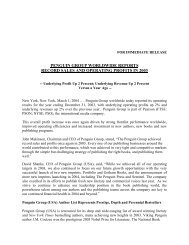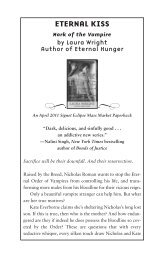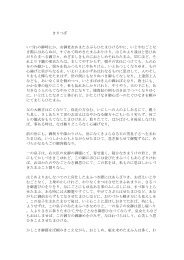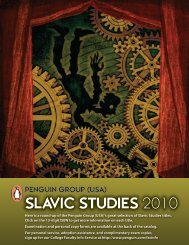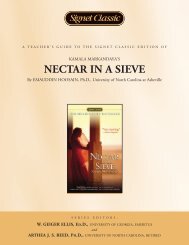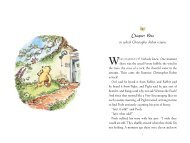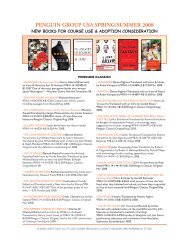Christopher Marlowe's Doctor Faustus - Penguin Group
Christopher Marlowe's Doctor Faustus - Penguin Group
Christopher Marlowe's Doctor Faustus - Penguin Group
Create successful ePaper yourself
Turn your PDF publications into a flip-book with our unique Google optimized e-Paper software.
20<br />
ACT I, SCENE I<br />
A Teacher’s Guide to the Signet Classics Edition of <strong>Christopher</strong> Marlowe’s <strong>Doctor</strong> <strong>Faustus</strong><br />
1. Why does Dr. <strong>Faustus</strong> decide to “read no more” logic? (line 10)<br />
2. Discuss the significance of the doctor’s lament: “Yet art thou still but <strong>Faustus</strong> and a man.”<br />
3. Analyze <strong>Faustus</strong>’ tone when he says “When all is done, divinity is best.” (line 35)<br />
4. Contrast <strong>Faustus</strong>’ proclamation “What will be, shall be! Divinity, adieu!” with the quotation above.<br />
(lines 35, 46)<br />
5 Why does Marlowe create the good and bad angel characters?<br />
6. Why might Valdes want “all nations to canonize us?” (line 114)<br />
ACT I, SCENE II<br />
1. What is the fear of the two scholars?<br />
2. Explain the irony when Dr. <strong>Faustus</strong> calls forth devils and then finds one “too ugly.” (line 26)<br />
3. Discuss the ambiguity when Mephostophilis says <strong>Faustus</strong>’ conjuring was the immediate, but<br />
not ultimate cause of the devil’s appearance? (line 45)<br />
ACT I, SCENE III<br />
1. Discuss the significance of Mephostophilis’ explanation for Lucifer’s fall: “by aspiring pride<br />
and insolence, From which God threw him from the face of heaven.” (lines 66-67)<br />
2. What is the symbolic meaning of the bridge Dr. <strong>Faustus</strong> aims to build? (line 104)<br />
ACT I, SCENE IV<br />
1. What is the purpose, other than comic relief, of the scene between Wagner, Robin, and two devils?<br />
2. What is the difference between the clowns’ goals for conjuring and <strong>Faustus</strong>’?<br />
ACT II, SCENE I<br />
1. Explain <strong>Faustus</strong>’ use of metaphor in “The god thou serv’st is thine own appetite.” (line 11)<br />
2. What internal struggle is <strong>Faustus</strong> undergoing as illustrated by the reappearance of the good<br />
and bad angels?<br />
3. What is the allegorical significance of <strong>Faustus</strong> signing his deed in blood?<br />
4. What is the inscription that appears on the doctor’s arm? Is it actual, or a figment of <strong>Faustus</strong>’<br />
imagination? Discuss your answer.<br />
5. What does Mephostophilis mean when he exclaims, “All places shall be hell that is not heaven!”<br />
(line 131) What is the irony in this line?<br />
6. Why can’t Mephostophilis provide <strong>Faustus</strong> with a wife? Why is this limitation significant?<br />
ACT II, SCENE II<br />
1. Describe Dr. <strong>Faustus</strong>’ feelings at the beginning of scene ii.<br />
2. What reason does <strong>Faustus</strong> give for not repenting?<br />
3. Why won’t Mephostophilis name the maker of the world? What similarity exists between this<br />
situation and the devil’s inability to provide a wife?<br />
4. What threat does the bad angel use to keep <strong>Faustus</strong> from repenting? This is the first of many<br />
references to dismemberment in the play. To what type of dismemberment has <strong>Faustus</strong> already<br />
committed?<br />
5. <strong>Faustus</strong> watches a show of the Seven Deadly Sins. Of which of these is he guilty?<br />
ACT II, SCENE III<br />
1. In this comic scene between Dick and Robin, Robin threatens to “clap . . . a pair of horns” on<br />
his master’s head. What might Marlowe be insinuating about Dr. <strong>Faustus</strong> here?<br />
2. Why does this clown scene appear directly after the previous one?





